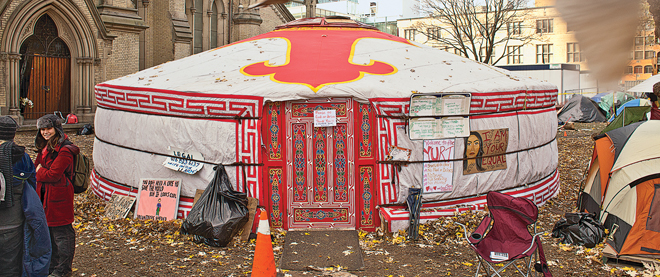Welcome to my yurt
Sales of the circular huts are booming as they catch on with both campers and protesters alike
Photography by Andrew Tolson
Share

Late last month the same central Asian dwelling appeared in both the posh Neiman Marcus Christmas catalogue and in the park where anti-consumerist protesters with Occupy Toronto remained camped out for the long haul: the yurt, that collapsible, cylindrical hut with a conical top that for eons has housed all classes of nomads, from simple shepherds to the Great Khan.
The Neiman Marcus yurt, dubbed the “Dream Folly,” starts at $75,000, boasts an interior designed to look like the inside of a genie’s bottle, comes equipped with a Plexiglas dome, and is billed as “the ultimate girls’ club.” Photographs make it look like Martha Stewart’s grotesque shrine to the cult of Moammar Gadhafi. The Toronto protesters, meanwhile, got three authentic yurts for $20,000: imported from Mongolia by Gatineau, Que.-based Groovy Yurts Inc., they stand swathed in high-quality sheep’s felt, are covered in whimsical Mongolian designs, and sheltered Occupy Toronto’s library, media centre, assembly space and health clinic. In such incongruous pairings can the voice of the zeitgeist be heard: finally, millennia after the Greek historian Herodotus described the Scythians camping out in them, the yurt’s time has come in the West, where they’re now big business. Purveyors report sales as much as doubling, thanks to two contradictory trends—an appetite for roughing it à la luxe on one hand, and apocalyptic fears of a collapsed economy on the other.
The yurt has made its trek into modern times with few alterations: the true Mongolian yurt is assembled on the bare earth using a series of latticed wooden sections brought together in a circle, with wooden rafters meeting in the centre. It’s a skeleton that can be put up and dismantled quickly but that gives the yurt an amazing durability against wind and snow. Clad in layers of canvas and felt, it is bound together using horsehair ropes, with carpets thrown down on the packed dirt.
Earthy stuff, but enthusiasts attribute an otherworldliness to the little yurt. “People have always found the space calming and deeply meaningful,” says Alex Cole of Little Foot Yurts, a Wolfville, N.S., yurt-making business, “in the same way that when they go into St. Paul’s Cathedral; or a Hindu yantra or a Buddhist wheel of life, it’s symbolic of things like life cycles.” Others just appreciate yurts as a comfortable camping option—for “glamping” (glamorous camping), in other words.
A recent Guardian article extols the virtues of a yurt vacation on one of the Canary Islands—“I didn’t realize just how luxurious the Eco Yurt Royale would be.” Similar yurtish abodes have surfaced at Oregon’s Three Sisters backcountry ski concern (where they are the newfangled Swiss chalet) and in Potsdam, Germany, where a romantic night for two in a yurt, including dinner and champagne, costs $350. The unemployed in Gwynedd, Wales, are making yurts, part of a retraining program, available to buy in London for $4,900. Bruce Peninsula National Park, northwest of Toronto, put 10 yurts up just months ago; Nova Scotia’s Kejimkujik National Park is making a yurt available to cross-country skiers this winter at $55 a night. On the Baie-des-Chaleurs, in Gaspésie, bed and breakfasters can sleep in floating yurts out on the water.
Others like yurts for longer-term living. Patrick Ladisa, who with partners founded his Pickering-based yurt-making company, Yurta, in 2004, has seen his business double in the past 12 months, with traffic to his website quadrupling in the same period. “Most of our clients actually live in their yurts permanently,” he says (in Canada such arrangements usually require an insulated foundation). Ladisa is part of a cottage industry of yurt-makers and importers that’s sprung up, particularly in Canada, over the last decade, whose yurts cleave to traditional central Asian techniques, and eschew modern synthetics they say can lead to unhappy results like mould.
Among these is Cole’s Little Foot, and Groovy Yurts, where the Occupy Toronto protesters shopped. Yves Ballenegger, owner of Groovy Yurts, attributes some of the new interest to anxiety over the future—“a fear some have that they will lose everything in 2012.” It’s no surprise that a portable home you can throw up and pull down in hours, and which is cheap—a year-round yurt doesn’t have to cost much more than $15,000—has an anti-establishment following. Many municipalities don’t even regard them as permanent dwellings, meaning they fly beneath the requirements of building codes even while some house families full-time. If regulation does exist, some just don’t care: “They just throw their yurt up and say, ‘It’s my land, this is a tent—that’s it, that’s all,’ ” says Ladisa.